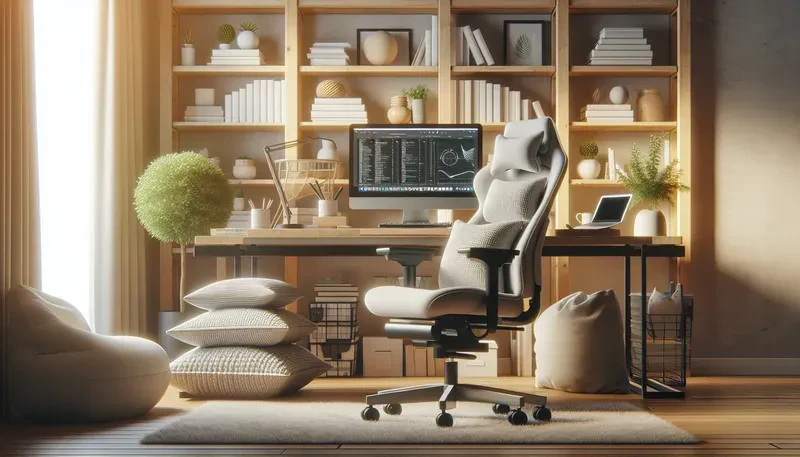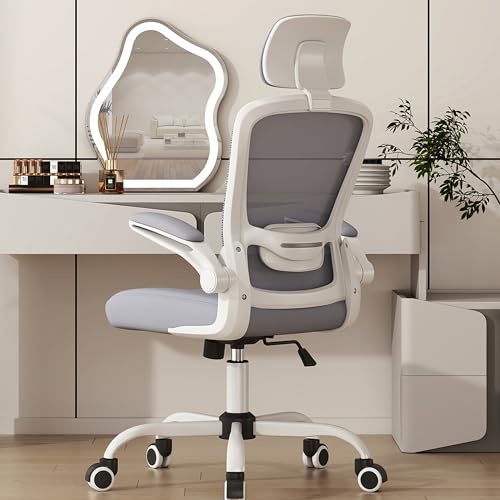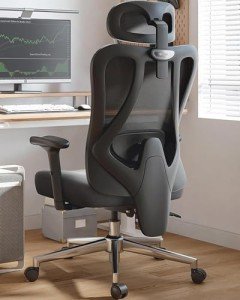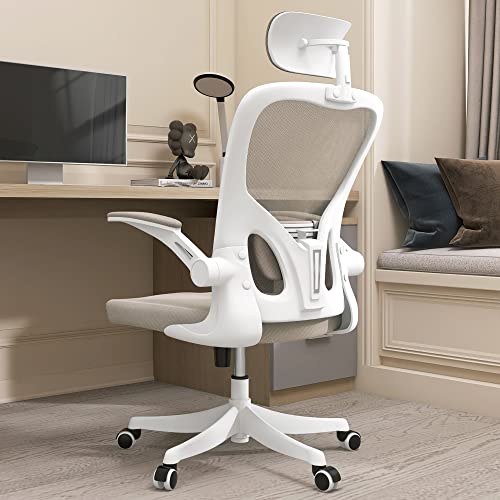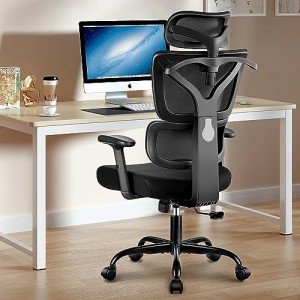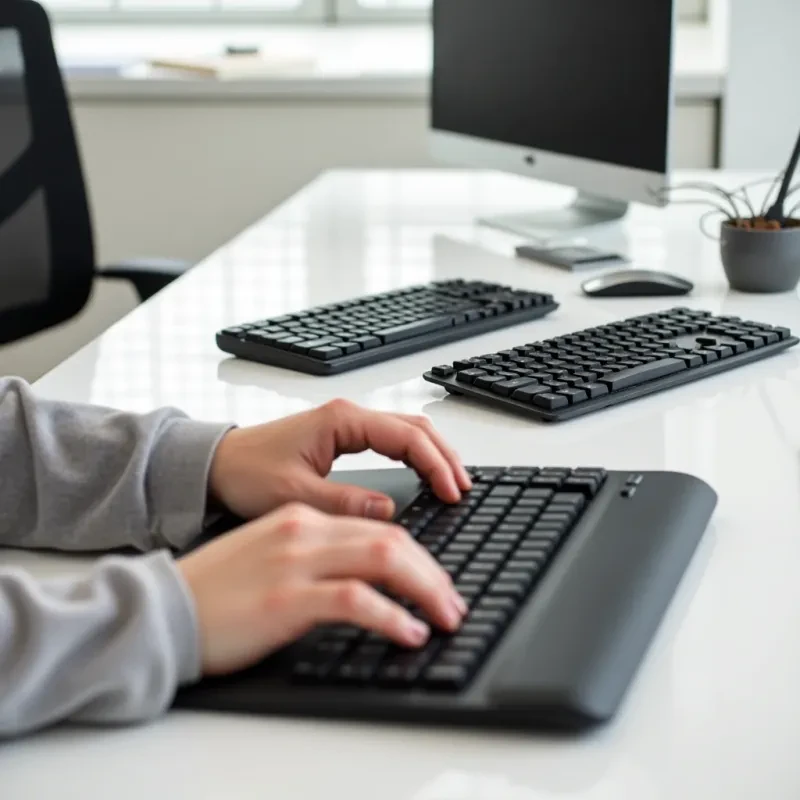When it comes to creating a home office, one of the most important pieces of furniture you'll need is a comfortable and supportive chair. This is not just about aesthetics; a good ergonomic chair can make a significant difference to your overall health and productivity. With long hours spent working, it's essential to choose a chair that promotes good posture and reduces strain on your body to avoid issues like neck pain from office chair use. One of the top picks for comfort and support is the Herman Miller Aeron Chair. This chair is designed to fit the natural contours of your body, offering both lumbar support and breathability with its mesh fabric. Its adjustable features, including seat height and armrests, allow you to customize it to your ergonomic needs for the ideal ergonomic desk setup. Many users rave about how this chair minimizes discomfort during extended periods of sitting.
Another excellent choice is the Steelcase Leap Chair. Known for its adaptability, the Leap chair supports a wide range of postures. Its LiveBack technology allows the backrest to flex with your movements, providing continuous support for proper desk ergonomics. Additionally, the chair's seat depth and height adjustments help ensure that you maintain proper alignment, significantly enhancing your comfort throughout the workday.
If you're looking for something with a more classic feel, consider the Secretlab Titan Evo 2022 Series. While initially designed for gamers, this chair offers exceptional support and comfort for anyone working long hours. It features a memory foam lumbar pillow and a multi-tilt mechanism, allowing you to find your ideal ergonomic position at your desk. Plus, its sturdy construction means it's built to last, providing great value for your investment.
Desks That Boost Productivity and Health
Working from home can be a double-edged sword. While it offers flexibility, it can also lead to discomfort and distraction if you don't have the proper desk setup. That's where desks designed for productivity and health come in. An ergonomic desk is not just a piece of furniture—it's a commitment to your well-being and efficiency during those long work hours.
One popular option is the adjustable standing desk or sit-stand desk, which allows you to switch between sitting and standing throughout the day. This flexibility can help reduce back pain and improve circulation. Studies show that alternating your position can keep you energized and focused, so you can tackle tasks with renewed vigor. Many models even come with programmable height settings, making it easy to find your perfect working position for correct desk ergonomics.
Another great choice is a desk with built-in organization features. Desks equipped with drawers, shelves, and cable management systems help keep your workspace clutter-free, allowing you to focus on your work. A clean environment can enhance concentration and boost creativity, so opting for a desk with smart storage solutions is a step in the right direction.
Don't forget about material and design! A desk with a sturdy surface, soft edges, and a finish that complements your decor can create a pleasant work atmosphere. Natural materials, like bamboo or reclaimed wood, not only look great but also contribute to an eco-friendly workspace. Investing in a quality desk that aligns with your style can make your home office a place you actually enjoy spending time in. Proper lighting, both natural light and task lighting, is also key for an ergonomic desk layout that reduces eye strain.
Accessories to Enhance Your Workspace
Creating an ergonomic home office goes beyond just selecting the right chair and desk. Ergonomic accessories play a crucial role in optimizing your workspace for comfort and productivity.
One of the most effective additions is a quality monitor stand. This accessory allows you to adjust the height of your screen, ensuring proper monitor placement so that your eyes are level with the top of the monitor. This simple adjustment can help reduce neck strain and improve your overall posture as you work.
Another essential accessory is a wrist rest for your keyboard and mouse to ensure proper keyboard position and mouse placement. Ergonomically designed wrist rests provide wrist support, keeping your wrists in a neutral position as you type and navigate. This can help prevent repetitive strain injuries and musculoskeletal disorders to make your work sessions much more comfortable. Look for options made from soft, breathable materials that offer both support and cushioning.
Noise can be a major distraction in any workspace, so consider investing in a good pair of noise-canceling headphones. These can help create a quieter environment, allowing you to focus on your tasks. Additionally, many noise-canceling headphones come with built-in microphones, making them perfect for virtual meetings. Choose a pair that is lightweight and comfortable for extended wear.
Lastly, don't underestimate the power of proper lighting. A good desk lamp can reduce eye strain and improve visibility, especially during late-night work sessions. Look for adjustable lamps that allow you to change the angle of the light and the brightness level. Opt for warm-toned bulbs that are easy on the eyes, helping you to stay productive without discomfort. The right lighting is an essential part of an ergonomic office setup.
Tips for Creating an Ergonomic Setup
Creating an ergonomic setup in your home office can significantly improve your comfort and productivity. One of the first steps is to invest in an adjustable ergonomic chair that provides good lumbar support and allows you to customize chair height. This type of chair helps maintain the natural curve of your spine, reducing the strain on your back during long working hours. Make sure that your feet rest flat on the ground or on a footrest to promote an ergonomic position at your desk.
Another key element of computer desk ergonomics is your desk height. Ideally, your desk should allow your elbows to remain at a 90-degree angle while typing. If your desk isn't adjustable, consider using a keyboard tray or raising your monitor to eye level, which can help reduce neck strain. Position your screen an arm's length away to further enhance visual comfort, and use a glare-reducing filter if you find yourself straining to see your work.
Don't forget about ergonomic accessories for computer comfort that can make a big difference. A document holder can help position papers at eye level, reducing the need to constantly look down and strain your neck. Additionally, consider using an ergonomic keyboard and mouse to maintain a natural wrist position. These tools can alleviate discomfort and prevent repetitive strain injuries that often occur with regular computer use.
Finally, incorporate movement into your day. Take regular breaks to stand, stretch, or walk around. This not only helps alleviate physical tension but also boosts your overall energy and focus. Setting a timer can be a useful way to remind yourself to take these short breaks. Adopting micro-movements and ensuring you are active throughout the day will complement your ergonomic desk setup and support your well-being in the long run.
By following these tips on how to set up your desk and make your desk ergonomic, you can create an ideal ergonomic desk setup that promotes comfort, productivity, and helps avoid issues like neck pain from office chair use. The right combination of an ergonomic chair, adjustable desk, proper lighting, and ergonomic accessories can transform your workspace environment. With some customization and adjustability, you can find the best desk for neck pain and an overall ergonomic office setup that works for you.
Choosing the Right Office Chair for Your Needs
When selecting an office chair, it’s crucial to consider your specific needs and preferences. Not all chairs are created equal, and what works for one person may not work for another. For instance, if you tend to work long hours, you might prioritize features like extra cushioning and adjustable lumbar support. On the other hand, if you frequently switch between tasks or collaborate with others, you may want a chair that is easy to move and adjust quickly.
Additionally, consider the chair's material. Some people prefer the breathability of mesh fabric, especially in warmer climates, while others might opt for leather or fabric for a more classic look. Each material has its pros and cons, so think about what will be most comfortable for you over extended periods.
The Importance of Desk Height
Desk height is another critical factor in creating an ergonomic workspace. A desk that is too high or too low can lead to discomfort and strain. Ideally, when seated, your elbows should be at a 90-degree angle, and your wrists should remain straight while typing. If your desk is not adjustable, you can use risers or a keyboard tray to achieve the correct height.
Moreover, the height of your monitor is equally important. The top of your screen should be at or just below eye level, allowing you to maintain a neutral neck position. This setup can help prevent neck and shoulder pain, which is common among those who spend long hours at a computer.
Incorporating Movement into Your Workday
Incorporating movement into your workday is essential for maintaining both physical and mental well-being. Sitting for prolonged periods can lead to various health issues, including obesity, cardiovascular disease, and musculoskeletal problems. To combat these risks, try to stand up and move around every 30 to 60 minutes. Simple activities like stretching, walking, or even doing a few quick exercises can help keep your blood flowing and your energy levels up.
Consider using a timer or an app to remind you to take breaks. You can also set up your workspace to encourage movement. For example, place your printer or filing cabinet further away from your desk, so you have to get up to access them. This small change can make a big difference in your daily activity levels.
Creating a Distraction-Free Environment
A distraction-free environment is vital for productivity, especially when working from home. To create a focused workspace, consider the layout of your office. Position your desk away from high-traffic areas and minimize visual distractions. If possible, use noise-canceling headphones or play soft background music to help drown out any distracting sounds.
Additionally, decluttering your workspace can significantly enhance your focus. Keep only the essentials on your desk and store away items that you don’t use regularly. A clean and organized workspace can help clear your mind and improve your concentration.
The Role of Natural Light
Natural light plays a significant role in creating a pleasant and productive workspace. Exposure to natural light can boost your mood, energy levels, and overall well-being. If possible, position your desk near a window to take advantage of natural light. However, be mindful of glare on your computer screen. You can use blinds or curtains to control the amount of light entering your workspace.
If natural light is limited, consider investing in full-spectrum light bulbs that mimic natural daylight. These bulbs can help reduce eye strain and create a more inviting atmosphere in your home office.
Personalizing Your Workspace
Personalizing your workspace can make it feel more inviting and comfortable. Adding personal touches, such as photos, plants, or artwork, can help create a positive environment that reflects your personality. Plants, in particular, can improve air quality and add a touch of nature to your office.
However, be careful not to overcrowd your workspace with too many decorations. A few well-placed items can enhance your environment without causing distractions. Striking the right balance between personalization and functionality is key to creating an effective workspace.
Investing in Quality Equipment
Investing in quality equipment is essential for creating a comfortable and efficient home office. While it may be tempting to go for cheaper options, high-quality chairs, desks, and accessories can make a significant difference in your overall comfort and productivity. Quality items are often more durable and provide better support, which can save you money in the long run by reducing the need for replacements.
When shopping for office equipment, take the time to read reviews and do your research. Look for products that have been tested for ergonomics and comfort. Many manufacturers offer warranties or trial periods, allowing you to test the equipment before making a final decision.
Maintaining Your Ergonomic Setup
Once you have created your ergonomic setup, it’s essential to maintain it. Regularly assess your workspace to ensure that everything remains in the correct position. As you change tasks or adjust your working style, you may need to make further adjustments to your chair, desk, or accessories.
Additionally, pay attention to your body. If you start to experience discomfort or pain, take a moment to evaluate your setup. Small changes, such as adjusting your chair height or repositioning your monitor, can often alleviate discomfort and improve your overall experience.
Conclusion: The Benefits of an Ergonomic Home Office
Creating an ergonomic home office is an investment in your health and productivity. By carefully selecting your chair, desk, and accessories, you can create a workspace that supports your well-being and enhances your efficiency. Remember to prioritize comfort, adjustability, and organization in your setup.
Incorporating movement, natural light, and personalization can further improve your workspace, making it a place where you enjoy spending time. By following these tips and maintaining your ergonomic setup, you can create an ideal environment that promotes comfort, productivity, and overall well-being. With the right combination of ergonomic furniture and thoughtful design, your home office can become a space that inspires creativity and supports your professional goals.
